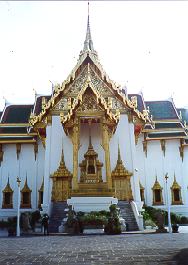Phra-Thinang Dusit Maha Prasat
(Dusit Maha Prasat Throne Hall)

Phra-Thinang Dusit Maha Prasat of the Phra Maha Monthian Group
This was constructed by King Rama I in 1789 on the site of an audience hall which was struck by lightning and burnt down during the early years of his reign.
The throne hall is built in the shape of a cross. Its four wings are covered with four-tiered roofs from the centre of which rises a beautiful nine-tiered prasat spire, the base of which is supported by four Garudas clasping
Nagas. Its north wing leads to a window-throne for formal outdoor receptions which is now seldom used, the last occasion being when King Rama VI received the oath of fealty from the court after his coronation in 1911.
Inside the hall are a throne inlaid with mother-of-pearl, surmounted by a nine-tiered white canopy and a bed inlaid also with mother-of-pearl, today used as an altar. In the south wing is a window in the form of a throne built by
King Mongkut (King Rama IV) rather resembling King Narai's throne in the Palace at Lopburi. The interior walls are painted with delicate designs. The hall
communicates with an apartment called "Phiman Rataya", situated in a garden. Dusit Hall is noted for its pure style and dignified simplicity. This hall was used for coronations, formal audiences and for the revision of the
Buddhist scriptures. Since the death of King Rama I, it has been the place for lying-in-state. It is also used for certain royal functions like merit making. Out of the special ceremonies that takes place here annually is the
commemoration of coronation day. King Rama III used to give audience here to the Court while he resided at Phra Maha Prasat during the renovation of his regular residence.
Phra-Thinang Phiman Rataya
This is connected to the projection of Dusit Maha Prasat lenghtwise towards the south. It is raised high above the ground, with pillared enclosures on three sides; east, west and south. The roof is in three tiers of coloured
glazed tiles. The carved gable portrays Brahma mounted on a hamsa bird. The pediment-like niches above the doors are in stylized arch form with peony patterns while those above the windows are in typical Thai design.
King Rama IV built a garden to the right of it. Since space was limited he had the right wing pulled down and built a replica of Kailasa Mountain for the tonsure ceremonies of his children when they reached puberty.
Phiman Rataya used to be the sleeping quarters of kings when they took residence at the Maha Prasat. King Rama III stayed here for one whole year. Later during the reign of King Rama IV the remain of the
Queen Mother lay in state here. So did the remain of King Ananda Mahidol (King Rama VIII).
Buildings within the walls of the Dusit Maha Prasat
In the walls of the Dusit Maha Prasat, there are gates on each side with Mondop finial decorated with coloured glazed tiles. King Rama IV gave these gates their present form.
Two edifices inside the wall were built in the reign of King IV, :- Phra-Thinang Aphonphimok Prasat and Phra-Thinang Ratchakaranyasapha. On the wall to the west King Rama VI built disrobing pavilion.
Phra-Thinang Aphonphimok Prasat

Aphonphimok Pavilion on the wall surrounding the Dusit Maha Prasat.
Phra-Thinang Aphonphimok Prasat
On the wall around the Dusit Maha Prasat is Aphonphimok Pavilion, a lovely little pavilion in typical Thai style, built by King Mongkut
(King Rama IV) as a disrobing pavilion. In the old days the King was carried on a palanquin
to the shoulder-high step of the pavilion where he alighted and removed his ceremonial hat and gown before proceeding to the Dusit Audience Hall.
This pavilion was reproduced by King Chulalongkorn (King Rama V) at
Bang Pa-In Summer Palace and a replica of it was exhibited at the World Fair in Brussels in 1958.
Phra-Thinang Ratchakaranyasapha
To the south of Aphonphimok paviion is a small two-storey building in bricks and mortar. The roof is covered with slate tiles. The gable is carved with Vishnu on Garuda
surrounded by floral pattern and angels in adoration. The windows of the upper floor have pediment-like niches above them while the windows of the ground floor are square in shape.
It was built by King Chulalongkorn (King Rama V) to hold meetings of his Cabinet. At present it is used as the meeting hall of the King's Privy Council.
|



